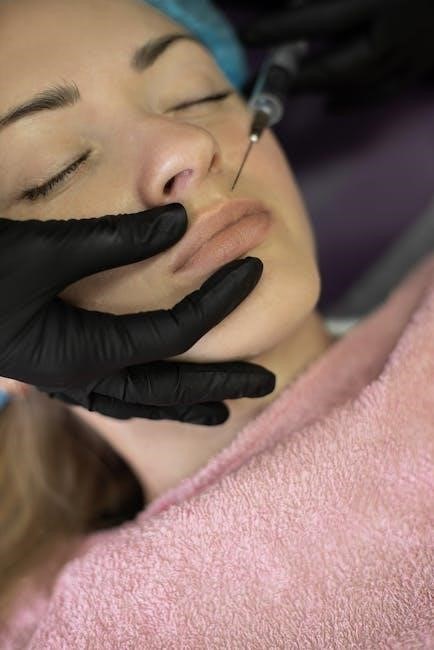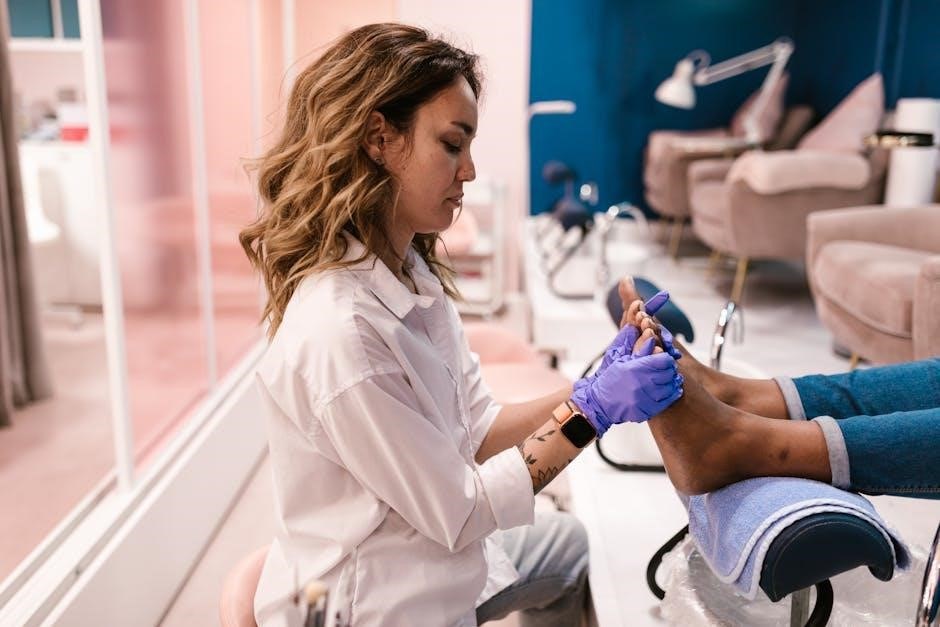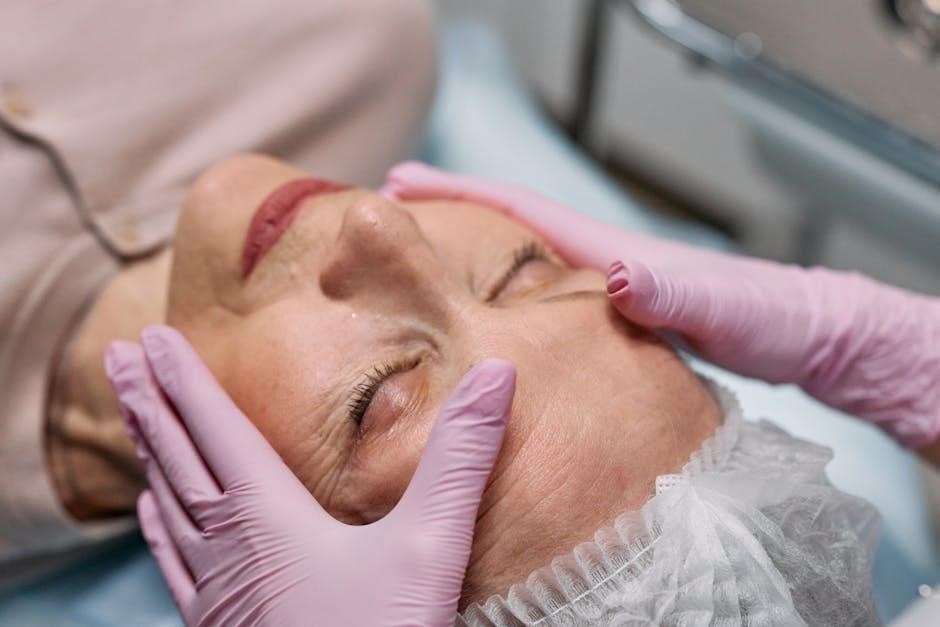Bladder irrigation involves flushing the bladder with a sterile solution to remove debris, such as blood clots or mucus, ensuring proper drainage and catheter function.
Definition and Purpose
Bladder irrigation is a medical procedure involving the introduction of a sterile solution into the bladder to flush out debris, such as blood clots, mucus, or sediment. Its primary purpose is to maintain the patency of urinary catheters, prevent blockages, and ensure proper drainage. This procedure is commonly used in patients with indwelling catheters, especially after surgery or in cases of bleeding, infection, or obstructive debris. Regular irrigation helps prevent complications like urinary retention or catheter-related infections, ensuring the bladder remains functional and free from obstructions.
Importance of Bladder Irrigation in Medical Practice
Bladder irrigation is crucial in medical practice for maintaining catheter patency and preventing complications like blockages and infections. It ensures proper drainage, reducing the risk of urinary retention and associated health issues. Regular irrigation is vital for patients with indwelling catheters, especially after surgery or trauma, to remove debris and prevent obstruction. This procedure is essential for maintaining patient comfort, preventing long-term bladder damage, and ensuring the effectiveness of urinary catheterization. Proper irrigation techniques help minimize the risk of infections and promote overall urinary tract health.

Methods of Bladder Irrigation
Bladder irrigation can be performed using three primary methods: Continuous Bladder Irrigation (CBI), Intermittent Irrigation via a pump bag, and Manual Irrigation. Each method ensures effective bladder cleansing and catheter functionality.
Continuous Bladder Irrigation (CBI)
Continuous Bladder Irrigation (CBI) involves a steady flow of sterile solution, such as normal saline, into the bladder through a three-way catheter. This method is often used to flush out blood clots, debris, or mucus, ensuring the catheter remains unobstructed. The solution is administered continuously, with the flow rate adjusted according to medical orders. CBI is commonly employed post-surgery, particularly after bladder or prostate procedures, to maintain catheter patency and promote healing. It requires close monitoring to prevent complications like bladder distention or discomfort, ensuring effective irrigation and patient comfort throughout the process.
Intermittent Bladder Irrigation via Irrigation Pump Bag

Intermittent Bladder Irrigation uses a pump bag or syringe to flush the bladder at specific intervals. This closed-system method minimizes infection risk by maintaining a sterile environment. The irrigation solution, typically normal saline, is administered through a catheter, ensuring debris or clots are removed. This approach is ideal for patients requiring periodic irrigation without continuous flow. The pump bag allows for controlled delivery, while the closed system prevents contamination. Healthcare providers regulate the flow rate and volume based on patient needs, ensuring effective irrigation while maintaining patient comfort and preventing complications.
Manual Bladder Irrigation
Manual Bladder Irrigation involves using a syringe to flush the bladder with a sterile solution, typically normal saline. This method is simple and effective for removing debris or clots. A catheter is inserted into the bladder, and after draining urine, the irrigation solution is gently administered. The process is repeated as needed to ensure adequate cleansing. Manual irrigation is often preferred for its simplicity and lack of requiring advanced equipment, making it accessible for patients who need occasional or immediate irrigation without continuous flow.

Preparation for the Procedure
Preparation involves gathering supplies like catheter tip syringes, measuring containers, and irrigation solution. Patients are positioned comfortably, and sterile gloves and gowns are worn to prevent infection.
Supplies Needed
The essential supplies for bladder irrigation include a 60 ml catheter tip syringe, a measuring container, and normal saline solution for irrigation. A three-way catheter is often used, along with irrigation tubing and a drainage bag. Sterile gloves, gowns, and aseptic supplies are crucial to maintain infection control. Additional items may include alcohol swabs for cleansing ports and clamps to regulate fluid flow. Having all necessary materials ready ensures the procedure is performed efficiently and safely, minimizing the risk of complications.
Patient Positioning and Comfort
Patient Positioning and Comfort
Patient positioning and comfort are critical for a successful bladder irrigation procedure. The patient is typically placed in a supine position, with their legs slightly elevated to facilitate easy access to the urethral area. Proper draping is essential to maintain privacy and reduce anxiety. The healthcare provider should ensure the patient is comfortable and informed throughout the process. Explaining the procedure beforehand can help alleviate concerns and promote relaxation, which is vital for minimizing discomfort and ensuring the procedure’s effectiveness.
Preparation of Irrigation Solution
The irrigation solution is typically prepared using sterile normal saline (0.9% sodium chloride) to maintain isotonicity and minimize bladder irritation. The solution is often pre-packaged or prepared under sterile conditions to prevent contamination. The volume and concentration of the solution are prescribed by a healthcare provider, typically ranging from 50 to 100 mL for adults. The solution should be at room temperature to avoid causing discomfort during administration. Strict aseptic technique is essential during preparation to reduce the risk of infection. The prepared solution is then used immediately to ensure sterility and effectiveness.

Step-by-Step Procedure
- Insert the catheter into the bladder under sterile conditions.
- Drain all urine from the bladder completely.
- Administer the prepared irrigation solution gently.
- Monitor for any complications during the process.
Insertion of the Catheter
The insertion of the catheter is a critical step in bladder irrigation. Ensure the patient is properly positioned and comfortable. Sterile gloves and equipment are essential to prevent infection. Lubricate the catheter tip and gently insert it into the urethra until urine flows, indicating correct placement. For continuous irrigation, a three-way catheter is used. Inflate the balloon to secure the catheter in the bladder. Monitor for discomfort or resistance, which may indicate misplacement. Always maintain aseptic technique throughout the procedure to minimize infection risks.
Draining Urine from the Bladder
After catheter insertion, allow the bladder to drain completely. Urine will flow into the drainage bag or container. Ensure the flow is unobstructed and monitor for any visible debris or clots. If using a three-way catheter for continuous irrigation, the drainage lumen will direct urine into the bag. Regularly inspect the drainage system to ensure proper function. Document the amount, color, and consistency of the urine to assess the effectiveness of the irrigation. Maintain aseptic technique throughout to prevent contamination and infection risks.
Administering the Irrigation Solution
Once the bladder is drained, attach a syringe filled with sterile saline solution to the catheter. Gently push the solution into the bladder to flush out debris. For continuous irrigation, adjust the flow rate as prescribed. Monitor for resistance or discomfort, which may indicate blockages. Ensure the solution flows freely and the drainage system remains unobstructed. Document the volume and appearance of the irrigated fluid to assess effectiveness. Maintain aseptic technique to minimize infection risks and ensure patient comfort throughout the procedure.

Patient Management and Monitoring
Monitor for complications, maintain catheter function, ensure proper hygiene, and document irrigation outcomes to optimize patient care and prevent infection.
Monitoring for Complications
Diligent monitoring during bladder irrigation is crucial to identify potential issues promptly. Common complications include infections, catheter blockages, and bladder discomfort. Healthcare providers should watch for signs of distress, such as pain or difficulty urinating, and ensure the irrigation solution flows smoothly. Regular checks for clots, kinks in tubing, or sediment buildup are essential. If complications arise, immediate action should be taken, including consulting a physician. Proper documentation of observations and any interventions is vital for continuity of care and patient safety.
Documentation and Follow-Up
Accurate documentation of the bladder irrigation procedure is essential for tracking patient progress and ensuring continuity of care. Records should include the volume and type of irrigation solution used, the amount of fluid instilled and drained, and any complications observed. Follow-up appointments are scheduled to monitor the patient’s condition and assess the effectiveness of the irrigation. Patients are also educated on signs of potential issues, such as infection or catheter malfunction, to report promptly. Proper documentation and follow-up ensure optimal outcomes and adherence to medical guidelines.

Best Practices and Guidelines
Adhering to established medical guidelines ensures safe and effective bladder irrigation. Use sterile solutions, maintain aseptic technique, and monitor for complications to optimize patient outcomes and safety.
Aseptic Technique and Infection Prevention
Aseptic technique is crucial during bladder irrigation to prevent infections. Healthcare providers must wear sterile gloves and gowns, and use sterile equipment. The irrigation solution should be prepared under sterile conditions to minimize the risk of contamination. Proper hand hygiene and maintaining a sterile field are essential steps. Patients should also be educated on infection prevention strategies, such as cleaning the catheter insertion site and reporting any signs of infection promptly. Regular monitoring of the catheter and drainage system ensures early detection of potential issues.
Compliance with Medical Guidelines
Compliance with medical guidelines is essential for safe and effective bladder irrigation. Adherence to established protocols ensures consistency and minimizes risks. Healthcare providers must follow specific instructions for solution preparation, irrigation volume, and flow rates. Regular training and updates on best practices are necessary. Documentation of the procedure, including volume of solution used and patient response, is critical. Compliance also involves monitoring for complications and reporting deviations from guidelines to maintain patient safety and optimal outcomes. Proper communication between healthcare teams ensures adherence to standardized care protocols.
Bladder irrigation is a critical procedure for maintaining urinary health and catheter functionality. Proper technique and adherence to guidelines ensure safety and effectiveness, improving patient outcomes significantly.
Bladder irrigation is a procedure to flush debris, blood clots, or mucus from the bladder using a sterile solution, ensuring proper drainage and catheter functionality. It is essential for patients with urinary catheters to prevent blockages and infections. The procedure involves preparing the irrigation solution, inserting a catheter, and administering the solution. Proper technique, including aseptic methods, is critical to avoid complications. Patient comfort, monitoring, and adherence to medical guidelines are vital for successful outcomes. Regular follow-up and documentation ensure continued bladder health and catheter patency.
Importance of Proper Technique and Patient Care
Proper technique in bladder irrigation is crucial to prevent infections and ensure effective removal of debris. Using sterile solutions and aseptic methods minimizes the risk of complications. Patient care involves ensuring comfort, monitoring for signs of distress, and providing clear instructions. Regular follow-up appointments and documentation of the procedure are essential for maintaining bladder health. Compliance with medical guidelines and attention to patient-specific needs ensure safe and successful outcomes, promoting long-term bladder function and overall well-being.